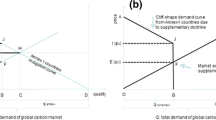Abstract
The Clean Development Mechanism (CDM), established by the Kyoto protocol, can generate substantial rents for project participants via the sale of Certified Emission Reductions. For this reason, supposedly technical decisions about the approval of CDM methodologies and about the registration of projects may be driven by benefits to specific countries or interest groups. Our econometric analysis of data for about 250 methodologies and about 1000 projects discussed by the CDM Executive Board (EB) so far, suggests that indeed, along with formal quality criteria, political-economic variables determine the final EB decision.
Similar content being viewed by others
References
Barrow, R., & Lee, J.-W. (2005). IMF programs: who is chosen and what are the effects? Journal of Monetary Economics, 52(7), 1245–1269.
CDM Watch (2005). Der Clean Development Mechanism (CDM) als Option in der Klimapolitik der Schweiz [The CDM as an option in Swiss climate policy]. Study commissioned by Greenpeace. http://www.greenpeace.ch/fileadmin/user_upload/Downloads/de/Klima/cdm_studie.pdf. Accessed 23 January 2008.
Cropper, M. L., Evans, W. N., Beradi, S., Ducla-Soares, M. M., & Portney, P. R. (1992). The determinants of pesticide regulation: a statistical analysis of EPA decision making. Journal of Political Economy, 100(1), 175–197.
Dreher, A., Sturm, J.-E., & Vreeland, J. R. (2009a). Global horse trading: IMF loans for votes in the United Nations Security Council. European Economic Review, 53(7), 742–757.
Dreher, A., Sturm, J.-E., & Vreeland, J. R. (2009b). Development aid and international politics: does membership on the UN Security Council influence World Bank decisions? Journal of Development Economics, 88, 1–18.
European Environment Agency (2006). Greenhouse gas emission trends and projections in Europe 2006. Copenhagen: EEA Report 9/2006.
Figueres, C., & Bosi, M. (2006). Achieving greenhouse gas emission reductions in developing countries through efficient lighting projects in the Clean Development Mechanism. Mimeo. Washington: The Carbon Finance Unit at the World Bank.
Fleck, R., & Kilby, C. (2006). World Bank independence: a model and statistical analysis of U.S. influence. Review of Development Economics, 10(2), 224–240.
Frey, B. S. (1984). The public choice view of international political economy. International Organization, 38(1), 199–223.
Frey, B. S. (1997). The public choice of international organizations. In D. C. Mueller (Ed.), Perspectives on public choice. Cambridge: Cambridge University Press.
Hird, J. A. (1990). Superfund expenditures and cleanup priorities: distributive politics or the public interest? Journal of Policy Analysis and Management, 9(4), 455–483.
Kaja, A., & Werker, E. (2009). Corporate misgovernance at the World Bank. Harvard Business School Working Paper, 09-108.
King, G., & Zeng, L. (2001). Logistic regression in rare events data. Political Analysis, 9(2), 137–163.
Kuziemko, I., & Werker, E. (2006). How much is a seat on the Security Council worth? Foreign aid and bribery at the United Nations. Journal of Political Economy, 114(5), 905–930.
Michaelowa, A., & Michaelowa, K. (2007). Climate or development: is ODA diverted from its original purpose? Climatic Change, 84(1), 5–22.
Oates, W. E., & Portney, P. R. (2003). The political economy of environmental policy. In K. G. Mäler & J. R. Vincent (Eds.), Handbook of environmental economics, vol. 1 (pp. 325–354). Amsterdam: Elsevier.
Sandler, T. (1992). Collective action. Theory and applications. New York: Harvester Wheatsheaf.
Sandler, T., & Hartley, K. (2001). Economics of alliances: the lessons for collective action. Journal of Economic Literature, 39, 869–896.
StataCorp (2005). Logistic postestimation. In StataCorp, Stata base reference manual, volume 2, K-Q, release 9 (pp. 69–92). College Station: Stata Press.
UNFCCC (2002). Report of the Conference of the Parties on its seventh session, held at Marrakesh from 29 October to 10 November 2001. Addendum. Part two: action taken by the Conference of the Parties, volume II, paragraph 43. FCCC/CP/2001/13/Add.2. Bonn: UNFCCC.
UNFCCC (2006). Report of the Conference of the Parties serving as the meeting of the Parties to the Kyoto Protocol on its first session, held at Montreal from 28 November to 10 December 2005. Addendum. Part two: action taken by the Conference of the Parties serving as the meeting of the Parties to the Kyoto Protocol at its first session. FCCC/KP/CMP/2005/8/Add.1. Bonn: UNFCCC.
UNFCCC (2007a). Project activities. http://cdm.unfccc.int/Projects/index.html. Accessed 23 January 2008.
UNFCCC (2007b). EB meetings. http://cdm.unfccc.int/EB/index.html. Accessed 23 January 2008.
UNFCCC (2007c). GHGs without LULUCF. http://unfccc.int/files/ghg_emissions_data/applications/x-zip-compressed/ai_total_wolulucf.zip. Accessed 23 January 2008.
UNFCCC (2007d). Baseline and monitoring methodologies. http://cdm.unfccc.int/methodologies/index.html. Accessed 23 January 2008.
URC (2007). Welcome to the UNEP Risoe CDM/JI pipeline analysis and database. http://www.cdmpipeline.org. Accessed 5 November 2007.
U.S. Department of Energy (2007). Energy information administration, international energy outlook 2007. Washington: U.S. Department of Energy.
Vaubel, R. (1986). A public choice approach to international organization. Public Choice, 51, 39–57.
Vaubel, R. (1991). The political economy of the International Monetary Fund: A Public Choice analysis. In R. Vaubel & T. D. Willet (Eds.), The political economy of international organizations. A public choice approach. Boulder: Westview Press.
Vaubel, R. (2006). Principal-agent problems in international organizations. Review of International Organizations, 1(2), 125–138.
Vaubel, R., & Willet, T. D. (1991). The political economy of international organizations. A public choice approach. Boulder: Westview Press.
Wooldridge, J. F. (2002). Econometric analysis of cross section and panel data. Cambridge: MIT Press.
World Bank (2006). World development indicators, CD Rom. Washington: World Bank.
World Bank (2007). Carbon finance for sustainable development 2007. Washington: World Bank.
WWF (2007). WWF background note to the report “Is the CDM fulfilling its environmental objectives? An evaluation of the CDM and options for improvement” prepared for WWF by the Öko-Institut November 2007. Berlin: WWF. http://assets.panda.org/downloads/cdm_report_wwf_background_paper.pdf. Accessed 23 January 2008.
Author information
Authors and Affiliations
Corresponding author
Rights and permissions
About this article
Cite this article
Flues, F., Michaelowa, A. & Michaelowa, K. What determines UN approval of greenhouse gas emission reduction projects in developing countries?. Public Choice 145, 1–24 (2010). https://doi.org/10.1007/s11127-009-9525-9
Received:
Accepted:
Published:
Issue Date:
DOI: https://doi.org/10.1007/s11127-009-9525-9




